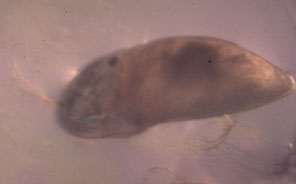
A single paramoecium, photo Adrian Burge
Paramecium as a food for killifish
Many young fish are so small when they first hatch that they can not eat traditional 'first foods' such as newly hatched artemia, microworms and vinegar eels. Amongst the nothos, this is particularly the case for N. janpapi, N. luekei and N. geminus - the Aphyobranchius subgenus. Other Nothobranchius, particularly from young parents, can also have similar problems (N. rachovii and N. patrizii spring to mind).
Infusoria is the collective name for microscopic organisms that dwell in bodies of water, feeding on detrietus and smaller single celled organisms, and include rotifers, and paramoecium. These micro-organisms live amongst plants, gravel, and in the filter, in fact anywhere they can. Squeezing out a sponge filter will yield a large number of these infusorians. For most (non-surface dwelling) fry it is ok to simply let them grow for a few days in a well matured tank with a sponge filter, or with a large clump of javamoss. A few days on and the fry will be eating newly hatched artemia nauplii - so why bother to raise paramoecium?
The smaller nothos (Aphyobranchius species) are surface dwellers, the newly hatched fry spending their first days living at the very surface of their tank - often in the meniscus around the edge. Because of this tendancy to remain near the water surface, the infusoria associated with plant matter is unavailable to the young fry, and can lead to starvation. paramoecium, on the other hand will stay near the waters surface if the tank is illuminated from above - exactly where the young fish need them. Another method is to have a slow air bubble (1 bubble/second) going to the surface (and bringing the paramoecium up without causing excessive turbulence.
Culturing Paramecium
Paramoecium are very easy to keep; as long as their water is clean, aerated and free of chlorine, they will thrive. I use aged tapwater. They can be fed easily with the smallest quantities of evaporated milk - just enough to give their water a slightly cloudy appearance. Collection is also relatively easy; if the culture is poured into a tall thin bottle, such as a clear wine bottle, the paramoecium can be seen congregating around the water surface, where they can be easily removed. This is not really necessary though as the culture can be simply poured (in part) in with your fry. Some people even add a tiny drop of milk in with the fry, just to get the paramoecium really thriving with the fry.
The greatest problem is with contamination - if any tank water gets into the cultures they will soon be outcompeted by other infusorians. Failure to feed them is not a major problem, as they will return even if unfed for many weeks.
Killi.co.uk is funded by its visitors. When you buy through links on our site we may earn an affiliate commission. For more info see
terms and conditions.
Mount Tremper, New York, 124**, UNITED STATES OF AMERICA
$300
Maybe it's an amoeba; I don't know my biology that well, but I do know that this platter is pretty fantastic. Tomato or brick red center with wavy white spokes emanating from it. Initials M H. embedded in one of those spokes. 15" long x 12 1 / 8" wide. Perfect condition, but check pics as they are part of the description. There are some red marks on the reverse that in no way impact how the piece appears. Frankly, I don't know what they are. When you hold this piece up to the light, tiny ...
more
Philadelphia, Pennsylvania, 191**, UNITED STATES OF AMERICA
$15
GIANT MICROBESPARAMECIUM (Paramecium caudatum)
Optics are AMAZING and can open up all sorts of unseen worlds! As Astronomers, our telescopes have been the gateway to Outer Space for countless new observers. A microscope is a similar gateway to the unseen worlds of Inner Space! For many students, peering into a microscope for the first time can be a shocking experience. A drop of water from a nearby stream can suddenly come to LIFE as the first glimpse of SOMETHING swims by. Say Hello to ...
more
Fort Campbell, Kentucky, 422**, UNITED STATES OF AMERICA
$8
Get your live vinegar eel starter culture today ?? perfect for baby fish, fry, and aquarists looking for a reliable infusoria alternative!
? What you get:
?? 1 oz of LIVE vinegar eels (BOGO OFFER ?? you??ll receive 2 oz total!)
?? Cultured fresh before shipping
?? Great for feeding bettas, guppies, fry, and more
? Easy to culture ?? just add apple cider vinegar, water, and apple slices. No extra tools or air pumps needed
? NO SHIPPING TO ...
more
New York, 100**, UNITED STATES OF AMERICA
$19
Live food for newly hatched fish. Living microorganism starter culture. Paramecium caudatum holds great significance for the healthy life of an aquarium. Together with other beneficial microorganisms, it participates in the decomposition and processing of leftover fish food and their metabolic byproducts. In the meantime it is a food source itself for baby fish and other animals Optimal growth temperature:71 6??( 22° C)
Instruction1. Open your order upon arrival 2. Open the bottle and ...
more
Angier, North Carolina, 275**, UNITED STATES OF AMERICA
$25
Infusoria Starter Culture ?? 1oz | LJ Group LLC
Kickstart your aquatic ecosystem with our premium 16oz Infusoria Culture, a live blend of essential freshwater microorganisms including ciliates, euglenoids, planktonic crustaceans, protozoa, and unicellular algae. Specially crafted for aquarists, this live culture provides an ideal first food for fish fry, shrimp larvae, and other small aquatic creatures
Product Highlights:
Live and Active Culture: Freshly bottled and ready to grow ...
more